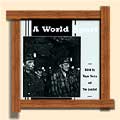 Heritage Community Foundation Presents
Heritage Community Foundation PresentsAlberta Online Encyclopedia
 |
||
  |
||
|
Home>> Issues and Challenges>> Labour and Politics>> Unions>> Featured Article: "Noi andiamo a Farnie bee chi" |
||
| "Noi andiamo a Farnie bee chi" | ||
|
By Mary Giuliano
I heard these statements from my mother Giuseppina, my husband Nick and from many other Italian immigrants who arrived in the Elk Valley between the early 1900s and the late 1960s. Strangely enough, although these were the first impressions for so many, these same people would tell you today that Italy is a great place to visit but they wouldn't want to live there permanently. What made them change their minds? What made the difference? From the perspective of most people of Italian descent in this area, the reason is they enjoy the local way of life and they have become accustomed to it. Not that it was an easy path to get from immigrant to Canadian citizen. Italians, like other immigrants, were not given any handouts. What they were given though, was the opportunity to work. And work they did. My father, Pietro Aiello, worked a full day at the local mill, then on evenings and weekends he worked either for himself or a local businessman. For a time, my mother worked as an assistant cook at the King Edward Hotel. As the oldest of four children, I did my share as well. I was expected to take care of my siblings, make meals and generally take care of things until my parents came home from work in late evening. Most of the Italian men became employed at the local coalmines—in Coal Creek first, then in Michel. A few, like my father and my husband, found work in the sawmills. The goal of the younger, better-educated man was to become a foreman at the mill or the mine; the older men worked hard digging coal underground or pulling lumber off the green-chain. Italian women living in Michel and Natal faced a difficulty their Fernie counterparts were spared. They spent considerable time trying to wipe off the layers of coal dust from their laundry hanging on outside lines and from furniture and other items inside. For me, the weeklong rail trip from Halifax to Fernie was filled with both stress and excitement. The stress came from not understanding the language, and watching my mother and other Italian women trying to make English-speaking people understand what they were trying to say. I recall my mother saying to the conductor, "Noi andiamo a Farnie bee chi, Farnie bee chi." ("We are going to Fernie, B.C.") One time she gave another passenger money to buy us bread. When she saw the soft mushy slices, she was instantly dismayed. "This isn't bread!" she exclaimed. Of course, being used to whole crusty homemade bread, the spongy texture of that loaf was foreign to her. As a youngster, crossing the Atlantic on the
ocean liner Saturnia, I found coming to Canada a great
adventure. To me the train ride across the prairies and the
mountains was exciting. I didn't care that I couldn't understand
the language. I loved Fernie. When I got off the train at the
rail station, I didn't see the wilderness my mother saw. She saw
strangely built wooden houses, barren streets, lack of family
and a language she didn't understand. I saw the many fields of
green, covered with yellow carpets of May dandelions and
buttercups. Those fields were like magic to my eyes. The
majestic mountains surrounding this tiny town made me feel
instantly at home. I loved the wide-open spaces, the way I could
look in every direction and see green trees. I would soon also
love the changing seasons—the bright blue skies of summer, the
breathtaking white of winter, and the orange leaves crunching
softly under my feet as I walked to school. During spring, I
loved even the knee-high water on Second Avenue that meant
complex manoeuvring onto the snow banks to get to school.
Arriving wet most of the time didn't deter me, even when I spent
the month of March sneezing. This article "Noi andiamo a Farnie bee chi: Italian Experience in the Elk Valley" by Mary Giuliano is reprinted from A World Apart: The Crowsnest Communities of Alberta and British Columbia, edited by Wayne Norton and Tom Langford (Kamloops BC: Plateau Press, 2002). The Heritage Community Foundation and the Year of the Coal Miner Consortium would like to thank the author and publisher for permission to reprint this material. |
||
 |
||
For more on coal mining in Western Canada, visit Peel’s Prairie Provinces.
![The Fernie Lodge was historically the most important being the vehicle by which local Italian miners separated themselves from their American counterpart and established their own model of a fraternal society. This photography shows a mature Italian community proud of its culture and traditions. Both men and women wear their sashes and the float features the principessa [princess].](/2217/20101208160619im_/http://www.coalking.ca/images/giuliano/02_unit10_thu.jpg)
